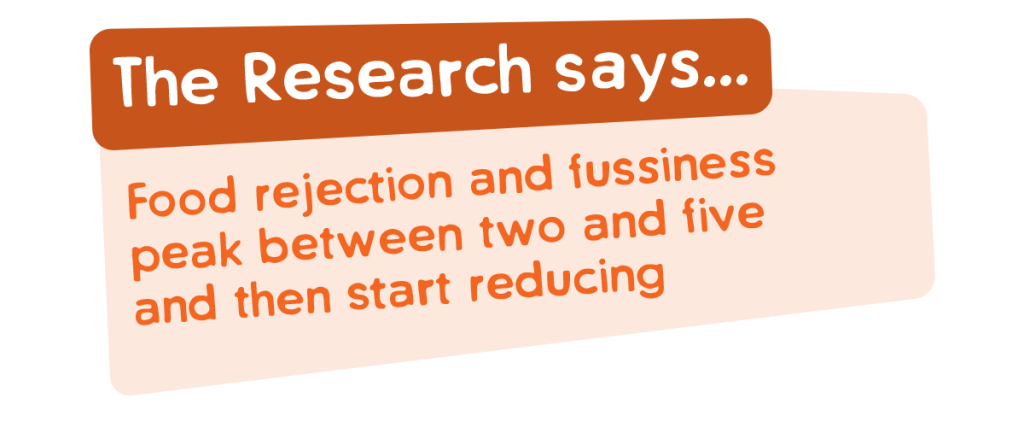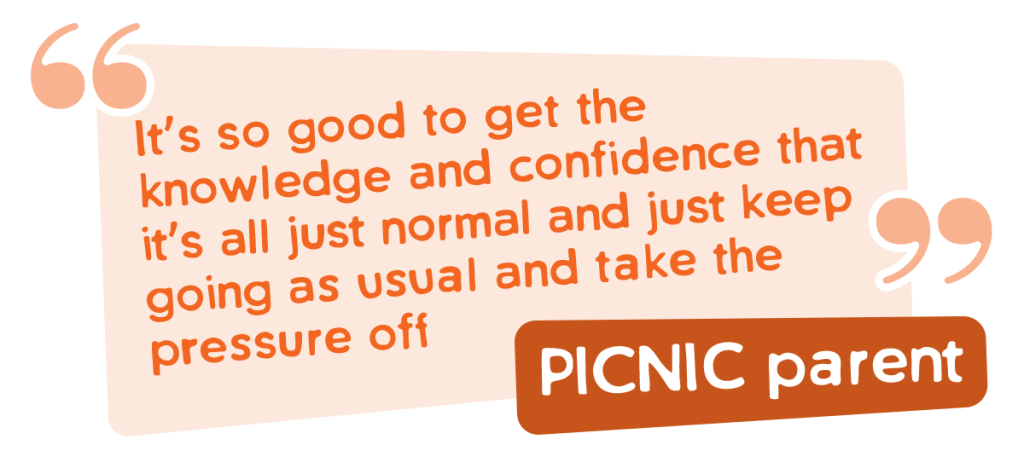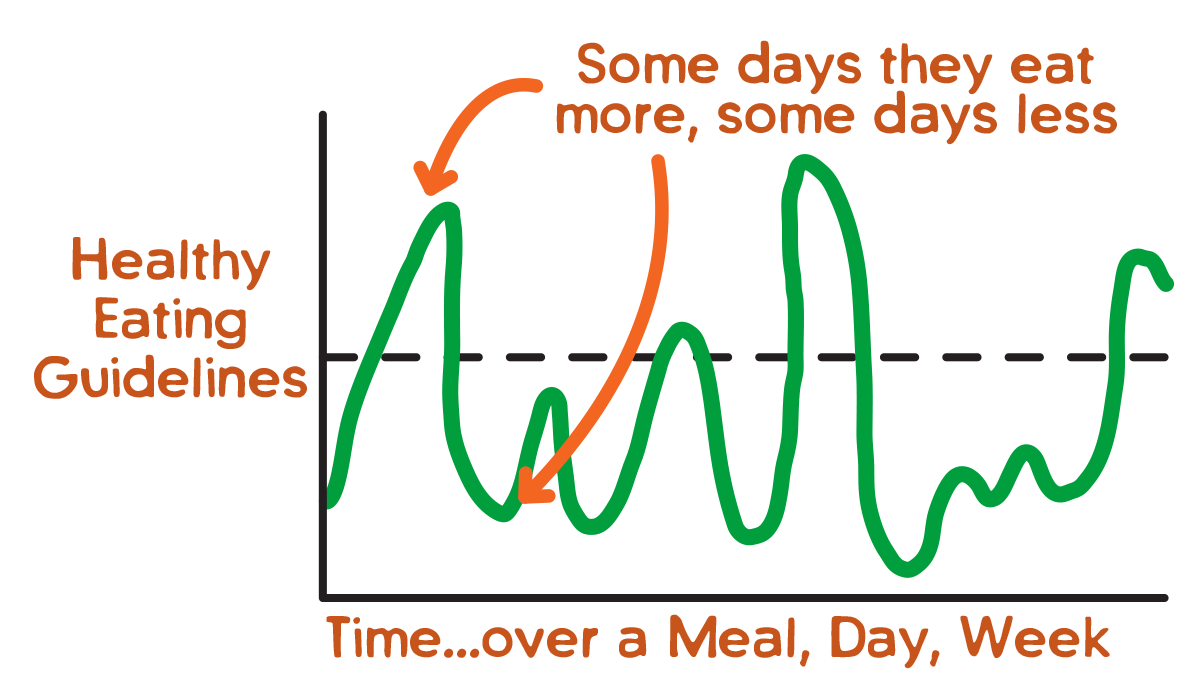Fussy eating and children
Summary
- Food rejection starts to reduce after children turn 5.
- Food rejection is normal and is historically protective.
- Children’s eating will be up and down at meals, over days and weeks.
- We feed in the same way whether or not we think they are ‘fussy’.
On this page
Fussy eating between 3-6 years
If feeding your child is difficult and you think they are fussy it may be that establishing the feeding roles didn’t go to plan when they were a bit younger and they started rejecting more foods. Parents who are faced with a toddler who starts rejecting more foods can find it challenging and stressful. It is common that the response to food rejection is offering alternative foods that you know they’ll eat or pressuring the child to eat. Both of these responses can lead to increased feeding issues and mealtime battles.
It isn’t too late to regain control of your feeding role and stop interfering with your child’s role. But it might take some adjusting as you both get used to the change. There are lots of tips you can take away and use within the pages on this website.

Food rejection is normal
Children being cautious and not accepting new foods straight away is thought to originate with our ancestors. Bitterness in foods and strong flavours may have been a sign the food was not safe to eat. The food could either have been poisonous or gone off. The strong smells and bitter tastes of vegetables and meat, or the look of foods can make children wary.

It’s good that our children are cautious with new foods and need to feel safe before eating them. Being wary of new foods is a survival instinct. The experts say that increased fussiness and food rejection starting when children are about 18 months is because they’re walking and spending more time away from their parents. They would have been more likely to eat something poisonous when eating foods away from their mother. The sensitivity of taste buds and caution of unknown foods were important for survival.

Feeding infants and children has been reported as one the most stressful things in parenting. When parents realise food rejection is normal in healthy children and can be an important sign of ‘being full’, it can reduce feeding stress and increase confidence. Eating new food is a skill infants and children learn gradually, a lot of learning to eat new foods looks like food rejection. It may be hard to see the improvement but learning to like and accept a new food can sneak up on you without you realising it.
You can’t make them like something, they need to learn to like it on their own terms, without pressure.
How children eat
Our children eating will be up and down, meal to meal, day to day, week to week.
That’s one thing we can count on. Things they liked at one meal will be rejected the next, things you think they won’t eat, they will, when you think they might be hungry they’re not, when you don’t think they are… you guessed it, they are!

We need courage and trust when they eat small amounts and larger amounts.
Fussy eating or not?
Around 50% of parents report their child is a ‘fussy eater’. But there is no agreed definition for what a fussy eater is. A lot of the ‘fussy eating’ labelling can be described as children’s natural caution with new food and the time required to learn to eat.
Children can be labelled ‘fussy’ depending on friends, family and parents’ expectations, if they appear to eat small amounts or if they take longer to accept and like a new food. There are lots of things that can contribute to whether a child is labelled fussy and most of these are normal.
If we think our child is fussy, we’re more likely to pressure and control their eating, making meals stressful, creating battles and making them feel less safe to learn to eat.
How do we feed children?
The pages within this age range (and overall site) provide suggestions and support for parents and carers on ‘HOW’ to feed. Links within this section will take you to more detailed information on specific topics.
Our feeding needs to be the same whether we think a child is fussy or not. We can become anxious when we feel they are not eating enough or not eating the variety needed for healthy growth. We need to stick to our own feeding roles, we provide the food, and they decide if they eat or not, and not pressuring them to eat.

Increasing variety in our toddler’s diet occurs by providing foods they are familiar with and eat regularly, and new foods they are getting used to seeing. We learn to eat new foods when we see them again and again and they become safe and familiar.
Provide your child with the structure to learn within, by providing regular mealtimes. Providing a safe place to learn to eat and become familiar with new foods is important. It makes the feeding practices we discuss on this site easier.
When to get more support
There are some toddlers or children whose feeding may require the support of health professionals. Some children may experience feeding difficulties which can affect their weight gain, development and nutrition status. For more information go to the When you need more support page.
- O’Brien M. Child-rearing difficulties reported by parents of infants and toddlers. Journal of pediatric psychology. 1996;21(3):433-46.
- Chan L, Magarey AM, Daniels LA. Maternal feeding practices and feeding behaviors of Australian children aged 12-36 months. Matern Child Health J. 2011;15(8):1363-71.
- Dovey TM, Staples PA, Gibson EL, Halford JC. Food neophobia and ‘picky/fussy’ eating in children: a review. Appetite. 2008;50(2-3):181-93.
- Wolstenholme H, Kelly C, Hennessy M, Heary C. Childhood fussy/picky eating behaviours: a systematic review and synthesis of qualitative studies. Int J Behav Nutr Phys Act. 2020;17(1):2.
- Taylor CM, Wernimont SM, Northstone K, Emmett PM. Picky/fussy eating in children: Review of definitions, assessment, prevalence and dietary intakes. Appetite. 2015;95:349-59.
- Satter E. Eating Competence: Definition and Evidence for the Satter Eating Competence Model. Journal of Nutrition Education and Behavior. 2007;39(5, Supplement):S142-S53.
- Vaughn AE, Ward DS, Fisher JO, Faith MS, Hughes SO, Kremers SP, et al. Fundamental constructs in food parenting practices: a content map to guide future research. Nutr Rev. 2016;74(2):98-117.
